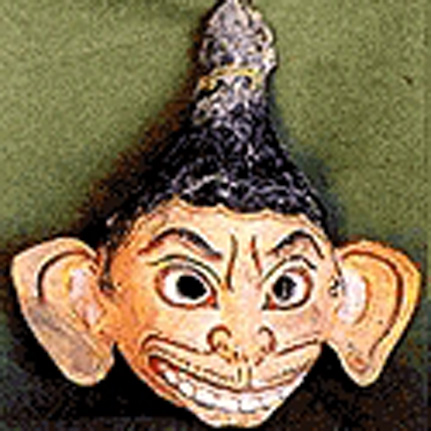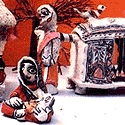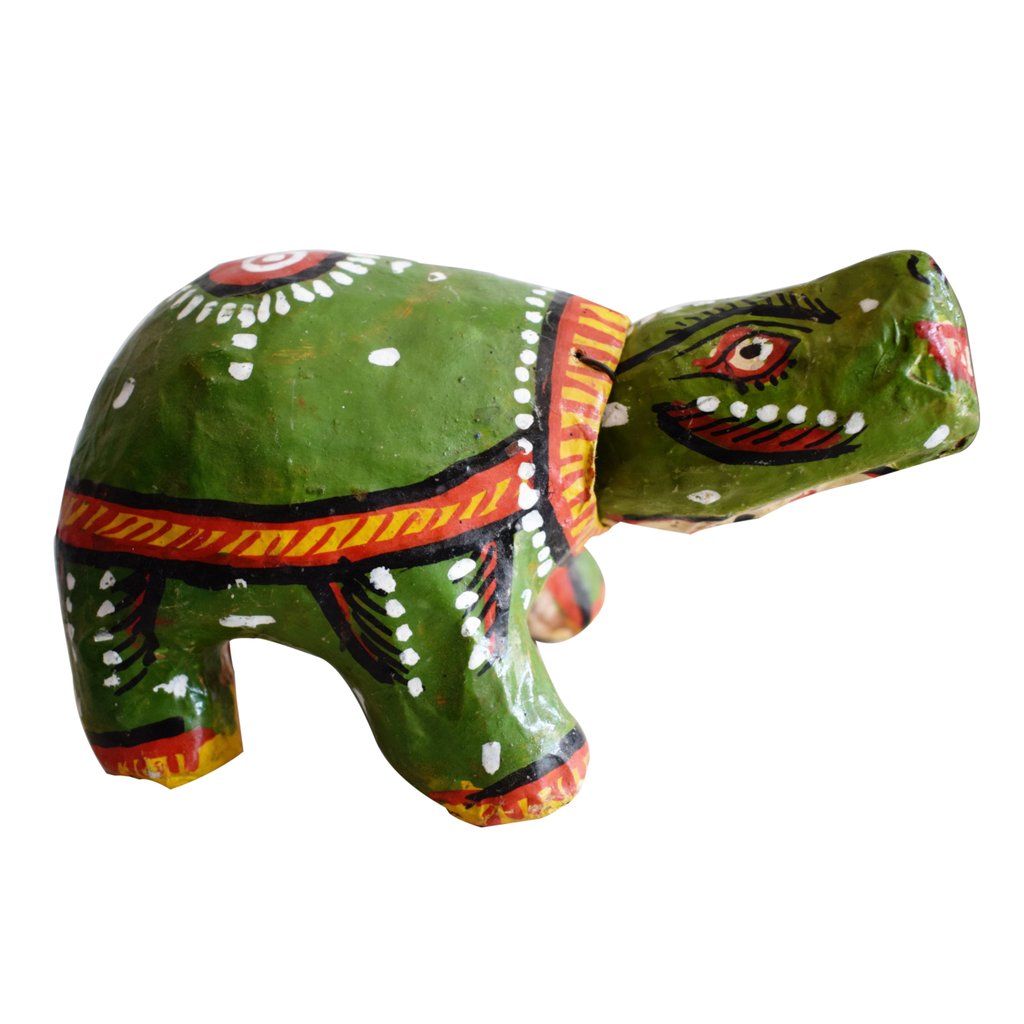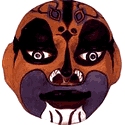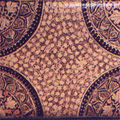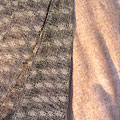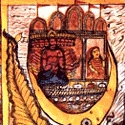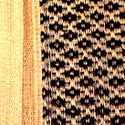Papier mache, a technique used in several parts of India involves manipulation of paper. The literal meaning being chewed or chopped paper, several adhesives such as clay, glue, starch provide strength and adaptability to convert the material into utilitarian and decorative products. The making process starts with degenerating paper by first soaking it in water. Once the matter is pounded to pulp - a crucial step to achieve smoothness in the final product, adhesives and wooden moulds are used to give shape to the treated paper. Successive layers are added as per the required thickness and further decorated with paint. Cards, File covers, folder, pen holders, jewellery boxes, masks are some of the products made out of papier mache in Assam. Masks made of papier mache and bamboo are particularly famous in Assam and worn by locals for local folk festivities.
This craft is found in Patna, Saraikella, Hazaribagh, Murhu, Khunti (Ranchi) and Madhubani. Masks used in the Chhau dance represent the main item of production; mobile figures of different kinds of birds for decorative purposes are also made. Mask-making is a hereditary trade with some families, though even in these families only those who are dancers are allowed to make masks. Originally, the masks were made of wood, and then bamboo; today they are made of papier mache.
Papier mache is a highly evolved craft of Delhi producing decorative utility items like pen stands, paper weights, boxes of all varieties, masks, puppets, bowls, glasses, plates, lampshades, wall hangings and decorations, mirror frames and other ornamented items. Located mainly in Kumbharka Mohalla of Mehrauli they use waste paper and clay, the big containers, decorated with pieces of glass, paint, and relief work, are light and lasting
The technique followed starts with the soaking of waste paper in water until it disolves into pulp, which is then beaten with stone and wood and then thoroughly mixed with with methi/fenugreek seed powder and wheat flour and made into a masala/paste. This mixture is used to create the basic product shapes. Then cut mirrors, glass and other shiny objects are pasted on in the areas designated and the product sun dried till it sets. The object thus shaped is then brightly colored and lacquered for a final shiny look.
The art of papier-mache is said to have come from Samarkhand to India in the time of Timur Lane, in the fourteenth-fifteenth centuries. The base of this craft is paper pulp coarsely mashed and mixed with copper sulphate and rice-flour paste. The figure is given shape by covering it with thin papers and then with layers of this mixture. The designers then sketch the designs intricately on the surface. Finally it is laquered and polished in bright colours. [gallery ids="176433,176432,176431,176430,176427"]
This craft is found in Patna, Saraikella, Hazaribagh, Murhu, Khunti (Ranchi) and Madhubani. Masks used in the Chhau dance represent the main item of production; mobile figures of different kinds of birds for decorative purposes are also made. Mask-making is a hereditary trade with some families, though even in these families only those who are dancers are allowed to make masks. Originally, the masks were made of wood, and then bamboo; today they are made of papier mache.
Although the craft of papier mache is not traditional to West Bengal, it has been nurtured over the recent years by the Santiniketan school of artists who have pioneered the craft and passed it on to many artisans. Many such artisans in and around Calcutta have taken up the craft as a serious occupation and their products --- mainly dolls and masks --- have found a market owing to their beautiful designs and excellent craftsmanship.
The products made from papier mache include human figures, birds, animals, caricatures, statues of gods and goddesses, and models of traditional religious centres like Khajruraho and Sanchi. Gwalior, Ujjain, Indore, and Harda are important centres for this craft. Gwalior is famous for its papier mache toys; Ujjain is famous for deities as well as for toys.
The minutely detailed craft, which - according to national awardee Mohd. Shafi Nagoo - requires 'education, patience, and eyesight' is incomparable for the fine painting work done on objects made of papier mache - all the painting, including filling in of colours, is done with a brush made of a single cat hair. Shafi Nagoo uses the Hindi proverb 'Sui se kua khodna (Using a needle point to dig a well) to convey the amount of delicate and patient work that underlines the artwork. Objects made of papier mache are built of paper pulp, or layers of paper pulp - hence the name papier mache or 'mashed paper'. However, the craft of papier mache refers, in practice, here actually to the technique of surface decoration rather than the creation of the body of the object. The craft was originally known in Kashmir 'by its Iranian name viz. Kar- i-Qalamdani' (Qalamdani = pen-case). It is believed that in the initial stages the craft was restricted to the ornamentation of pen-cases. The craft was also known as 'Kar-I-Munaqqash, which...could be because it was used for ornamenting smooth surfaces made of paper pulp or layers of polished paper'.



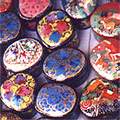
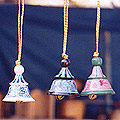
The desire to keep feet warm during winter months is fulfilled by paboos, the name given to the shoe of the area. Unlike leather shoes, the paboos afford protection against frost bite in snow or in very cold weather. The paboos are made of hessian cloth, used wool felt, coarse yak hair of and hair of the pashmina goat, and thigma. Leather is used for sole- making, while the hessian cloth and woollen felt are stitched together to make the base of the shoe. The coarse hair spun into thin rope is stitched together with the help of needle and used to make the sides of the shoe.
Nepal is famous for its finely woven pashmina shawls that are hand-made from the wool of the mountain goat or Capra hircus, which graze in the mountainous regions in altitudes ranging from 2,700 to 3,400 metres above sea level. In Nepal the shawls woven from the hair of this mountain goat are referred to as pashmina shawls, pashm being the Persian word for 'wool'. The warmest and most luxurious of animal fibres, the wool in its natural form is found in one of four colours: grey, white, black, and cream. As pashmina shawls have become a major item of trade, hand-spun pashmina wool is being replaced by imported machine-spun yarn. This has discouraged local production, thus reducing opportunities for both employment and income.

Pashmina shawls are exclusive products from Kashmir. Pashmina wool is used in both the warp and weft. The shawls are woven in the kani technique, which is similar to tapestry weaving in which different coloured “tillis” are used to make colourful patterns. Patterns are mainly inspired by Mughal designs.
This ancient art and craft of the traditional scroll painting used for story telling is known as patachitra. The Bengal patachitra is known for its depiction of stories from myth, legend, and the epics; while stories from events and happenings of the everyday are also part of their repertoire. Painted on a base of coarse cotton fabric, tussar silk and specially treated paper a rich colorful palate using natural colors is used to make the painting appear realistic and animated. This art and craft practice remains vibrant as its creative boundaries are pushed forward by the artists residing mainly in the Naya, Chandipur, Narajol and Daspur villages of West Bengal. The artists are skilled in both painting, storytelling and in treating the paper to make it strong and durable. In recent years, the makers have expanded their production to a range of products using their traditional creative motifs and designs. This is a hereditary craft, the painters here being known as patidars rather than the generic 'chitrakara'. The surface of the cloth is thickened with black earth, cow dung, and lac. The figure outlines are in lamp-black or red but the figures themselves are painted in vegetable colours. The figures are symbolic and bold and the style is vigorous and spontaneous. The scrolls are religious as well as social. Patidars used these scrolls for story-telling, with song and dance -- in the various villages.
In this craft, rough stones hewn from quarries are transported to the work site. The stone is cut to suitable sizes and outlines of the desired designs are marked with the help of geru or red oxide mixed with water. The sompura community of stone-carvers from Wadhwan in Kathiawar created the farmed Somnath and Dwarka temples. The carved stone brackets on the facades of old houses and temples in Gujarat are also the handiwork of the sompura community.


Literally the cloth picture(s)/painting(s) of Odisha, the patachitras, according to O.C. Gangoly, represent (in their original form) the 'icon paintings of Puri...of the Cult of Jagannath'. In Gangoly's survey of Odishan paintings, patachitras or pata paintings are defined clearly as a 'school of painting' linked intimately with the cult of Lord Jagannath (a prominent and powerful deity) and with the Jagannath temple in Puri (Odisha).

a 'class of hieratic [sic] forms of pictorial art of folk-significance which are not only unique in the history of Indian painting but are un-paralleled in the history of any form of European painting. By virtue of their strange and fantastic pictorial conceptions, their peculiar and idiosyncratic conventions, their strange and summary system of line formulations, and their deliberately wayward colour-schemes almost confined to three or four tones of bright primitive tints, they stand quite by themselves...'
The fact that the Sabara tribe of Odisha are still connected with some of the ceremonies in connection with the worship of the god, seems, in Gangoly's opinion, an acknowledgement of the fact that this cult once belonged to the tribal Sabaras but has been adapted and assimilated into the cults of Vaishnavism.'The Jagannath cult is of tribal origin. The Indrayumna legend of the Puri temple narrates that the deity was originally worshipped by the aboriginal Sabara chief, Visvavasu, in the forests and only later did it miraculously appear in Puri. Accordingly, the Jagannath figures still display what seems to be a tribal look.'

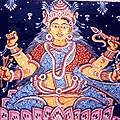
-
-
The canvas on which the painting is executed is created by gluing together two layers of (traditionally, cotton) cloth with glue made of tamarind (imli) seeds. This paste is made by (1) soaking tamarind seeds in water for about three days, (2) grinding them with a pestle till they are jelly-like in consistency, (3) mixing the ground pulp with water in an earthen pot, and (4) heating this into a paste traditionally called niryas kalpa
-
-
Soft clay stone is then powdered and mixed with the tamarind paste. Two or three coatings of this mixture are applied on the prepared canvas, on both sides. This stone is white in colour and chalk-like in consistency and is found in the Nilgiri mountains. Debaraj Maharana states that the chitrakars now buy this stone from local shops.
-
The canvas is then dried completely, a process that can take more than half the day, after which the cloth is cut into the required shape and size.
-
Finally, the surfaces are polished with a rough burnishing stone, and later with a smooth stone or wood. The pata is thus ready for being painted on.
-
After the canvas has been prepared, the images, borders and details are sketched on the prepared canvas, the outlines are coloured, and finally the inside spaces are filled in. Borders are an integral part of these paintings; they are made first, their width determined by the size of the pata. The outlines of the figures are drawn first, very thin lines in white. Colours are introduced, and the features and attire painted in. The outlines of other motifs are thickened with a black brush, and the small and fine decorative motifs are then painted in white.
-
After the painting is complete, it is apparently lacquered, thus making it water-resistant and durable.
-
White is obtained from the conch shell. The shells are powdered and boiled with the gum of the kaitha fruit till a paste is formed. When being used, a little of this paste is mixed with water.
-
Black is obtained from lamp black or lamp soot. A brass plate filled with water is placed on the flame of the lamp till a considerable amount of soot collects on the underside of the plate. This soot is mixed with the gum of the kaitha fruit to form a paste.
-
Red is derived from a red stone known as hingulal. This stone is powdered and mixed with water and gum, and red tablets are created, which are wet when used for painting. Dheu, another water-soluble material is also used for red.
-
Yellow is made from yellow stones called hartals, that are powdered, mixed with water and gum and made into pellets.
-
Green is made by boiling green leaves in a mixture of water and kaitha gum and/or by using powdered green stones boiled in the same combination of water and gum.
-
Blue is obtained from indigo and/or from a soft stone called rajabarta, powdered and boiled with water and gum.


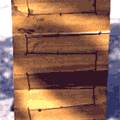
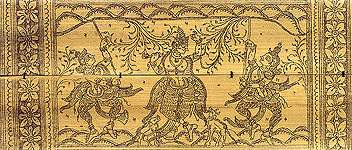
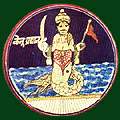
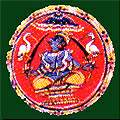
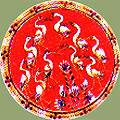
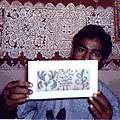
Extremely delicate, the mats made with kora / sedge grass are highly prized and valued; Kora grass grows abundantly along the banks of the rivers and in marshy areas and the mats are woven both in Tamil Nadu and Kerala. The process of creating the mat is complex and painstaking. In its original form the grass is green in colour and normally grows to a height of 3-4 feet. The grass for the mats is cut very finely while it is still green. The grass is collected in the months of September/ October and February/March. The inside white pith (choi) of the stem is removed with a sharp-edged knife while the outer part of the stem is used for weaving. The counts of the mat depend on how many strips the grass is cut into; the greater the number of strips from each stem the higher the count. The strips of grass are then dried in the hot sun. They are, however, never exposed to humidity, as they tend to turn black with the exposure. When the dried grass strips turn a yellowish greenish colour they are boiled in a pot of water and then dried again. The dried grass is made up into bundles and then soaked in running water. These bundles are weighed down with stones at both ends; they are then made to float in running streams of clean water. The weight of the stone is so adjusted that the grass remains just below the surface of the water. The grass is normally kept under water for three days, but sometimes it is kept under water for up to seven days, ensuring a very fine count. This wetting causes the grass to swell up to three times its original size. It is then dried again in the sun. The weaving is done on a floor loom. The process is slow and follows a basket weave pattern. The weft (or the grass) covers the warp entirely and the pattern formed has an interesting striped effect of its own. Once the weavings is complete, the mat is dried in the sun for a short while. It is then finished with a polishing stone. Traditionally only two colours --- red and black --- were used on the mats. For dyeing the grass both natural and chemical dyes are used. The natural dye is taken from sappon or Brazil wood and is fixed with an alum mordant. With the introduction of chemical dyes a wide range of colours have been introduced into the mats. The warp on which the grass mats are woven was traditionally made of elephant aloe fibre. However, the weavers have now started using cotton or silk yarn as a substitute in the warp while weaving. The warp is made by the men while the weaving is done by the women. The mats produced include the 5 feet x 3 feet sleeping mat, prayer mats, table mats, and panthi mats which are used to sit on while eating. The designs on the mats are constantly evolving, changing from simple stripes to reproductions of monuments, animals, plants, and trees. The mats woven in Pattamadai are very fine with counts ranging from 100 to 140. Kora mats are extremely reliable and can be easily folded.
Extremely delicate, the mats made with kora / sedge grass are highly prized and valued; Kora grass grows abundantly along the banks of the rivers and in marshy areas. The process of creating the mat is complex and painstaking. In its original form the grass is green in colour and normally grows to a height of 3-4 feet. The grass for the mats is cut very finely while it is still green. The grass is collected in the months of September/ October and February/March. The inside white pith (choi) of the stem is removed with a sharp-edged knife while the outer part of the stem is used for weaving. The counts of the mat depend on how many strips the grass is cut into; the greater the number of strips from each stem the higher the count. The strips of grass are then dried in the hot sun. They are, however, never exposed to humidity, as they tend to turn black with the exposure. When the dried grass strips turn a yellowish greenish colour they are boiled in a pot of water and then dried again. The dried grass is made up into bundles and then soaked in running water. These bundles are weighed down with stones at both ends; they are then made to float in running streams of clean water. The weight of the stone is so adjusted that the grass remains just below the surface of the water. The grass is normally kept under water for three days, but sometimes it is kept under water for up to seven days, ensuring a very fine count. This wetting causes the grass to swell up to three times its original size. It is then dried again in the sun. The weaving is done on a floor loom. The process is slow and follows a basket weave pattern. The weft (or the grass) covers the warp entirely and the pattern formed has an interesting striped effect of its own. Once the weavings is complete, the mat is dried in the sun for a short while. It is then finished with a polishing stone. Traditionally only two colours --- red and black --- were used on the mats. For dyeing the grass both natural and chemical dyes are used. The natural dye is taken from sappon or Brazil wood and is fixed with an alum mordant. With the introduction of chemical dyes a wide range of colours have been introduced into the mats. The warp on which the grass mats are woven was traditionally made of elephant aloe fibre. However, the weavers have now started using cotton or silk yarn as a substitute in the warp while weaving. The warp is made by the men while the weaving is done by the women. The mats produced include the 5 feet x 3 feet sleeping mat, prayer mats, table mats, and panthi mats which are used to sit on while eating. The designs on the mats are constantly evolving, changing from simple stripes to reproductions of monuments, animals, plants, and trees. The mats woven in Pattamadai are very fine with counts ranging from 100 to 140. Kora mats are extremely reliable and can be easily folded.
